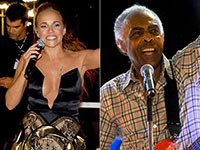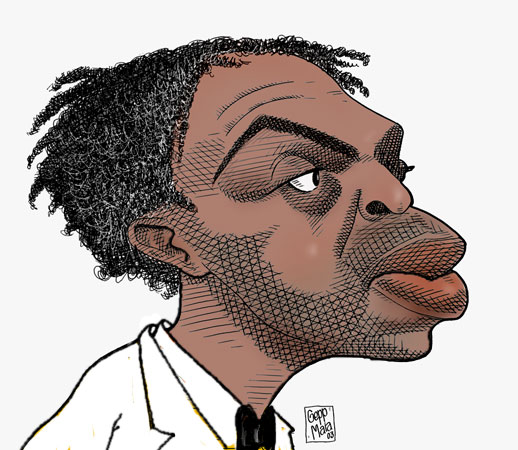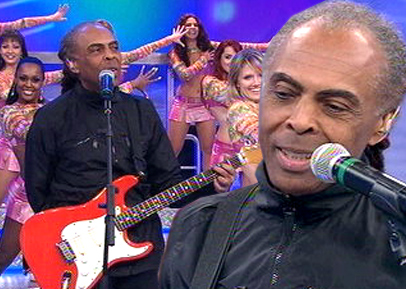Este post também está disponível em:
Português
English

Biography of Gilberto Gil
Gilberto Gil is one of the greatest personalities in Brazilian music, recognised worldwide. His international career has already earned him a Grammy in the Best World Music Disc category in 1998 and a Latin Grammy in 2003.
Gilberto Gil (born Gilberto Passos Gil Moreira) was born in Salvador and spent his childhood in Ituaçu, in the interior of Bahia, where he first became interested in music listening to Orlando Silva and Luiz Gonzaga.
Gilberto Gil moved to Salvador at the age of nine and began learning the accordion. At 18, he formed the group “Os Desafinados”. At the end of the 1950s, influenced by João Gilberto, he started playing the guitar.
While studying business administration, he learnt about contemporary classical music. In 1962, he recorded his first solo record and met Caetano Veloso, Maria Bethânia and Gal Costa. The following year, with Tom Zé joining the group, they performed “Nós, Por Exemplo” at the Vila Velha Theatre in Salvador.
Soon afterwards, Gilberto Gil moved to São Paulo, where he worked for the Gessy-Lever company. At that time he met Chico Buarque, Torquato Neto and Capinam.
In 1965, he sang the song “Iemanjá” at the 5th Festival da Balança, organised by the Academic Directory of the Mackenzie University Law School, which was recorded by RCA.
Gilberto Gil became known on the television programme “O Fino da Bossa”, hosted by Elis Regina, where he performed his compositions “Eu Vim da Bahia” and “Louvação”, among others. With his success, he quit his job and signed a contract with Philips, which released his first LP, “Louvação”, in 1967.
Back in Rio de Janeiro, Gilberto Gil took part in festivals on Record and TV Rio and even had his own programme on TV Excelsior, “Ensaio Geral”.
At the 3rd Record Festival in 1967, Gilberto Gil performed “Domingo no Parque” accompanied by the Mutantes, and won second place.
Caetano Veloso’s “Alegria, Alegria” came fourth and, together with “Domingo no Parque”, formed the embryo of the Tropicalist movement, which mixed elements from the cultural industry and materials from Brazilian tradition.
Unlike Bossa Nova, Tropicalism was critical and concerned with the country’s social problems.
In 1968, the LPs “Gilberto Gil” and “Tropicália ou Panis et Circensis” (Tropicália or Panis et Circensis) were released, a disc that featured, in addition to Caetano and Gil, Os Mutantes, Torquato Neto, Capinam, Gal Costa, Tom Zé and Nara Leão.
In 1969, Gilberto Gil and Caetano Veloso were labelled “subversives” by the military regime and went into exile in England. They returned to Brazil in 1972. Gil released “Expresso 2222” and “Refazenda”.
On the 1979 album “Realce”, he showed his interest in reggae and pop. LPs from this phase include “Luar”, “Um Banda Um”, “Extra”, “Raça Humana”, “Dia Dorim, Noite Néon” and “O Eterno Deus Mu Dança”.
Gilberto Gil worked with Jimmy Cliff and in 1980 released a Portuguese version of Bob Marley’s reggae hit “No Woman, No Cry”.
In 1993, with Caetano Veloso, he released “Tropicália 2”, which included rap on the track “Haiti”.
Between the discs “Quanta” and its live version, “Quanta Gente Veio Ver”, he released “O Sol de Oslo”, on the Pau Brasil label. In 2000, his partnership with Milton Nascimento resulted in the disc “Gil e Milton”.
Among his many hits, the biggest were “Preciso Aprender a Só Ser”, “Eu Só Quero um Xodó” (Dominguinhos/ Anastácia), “Punk da Periferia”, “Parabolicamará”, “Sítio do Pica-pau Amarelo”, “Soy Loco por Ti América” (with Capinam), “Realce”, “Toda Menina Baiana”, “Drão”, “Se Eu Quiser Falar com Deus” and many others.
From 1989 to 1992, Gilberto Gil was a councillor in the Salvador City Council for the Green Party. On 2 January 2003, he took up the post of Minister of Culture in the government of Luiz Inácio Lula da Silva, from which he resigned in July 2008 to devote himself to his artistic career.
Video about Gilberto Gil’s Biography

Gilberto Gil plays a fundamental role in modernising Brazilian Popular Music
Gilberto Gil plays a fundamental role in Bahia’s constant process of modernising Brazilian Popular Music.
On the scene for 46 years, he has developed one of the most relevant and recognised careers as a singer, songwriter and guitarist.
Gilberto Gil has been releasing albums all over the world since 1978, the year of his successful live performance at the Montreux Jazz Festival in Switzerland.
Every year he tours Europe, the Americas and the Orient with his infectious music, with a strong rhythmic tendency and melodic richness, in a mixture just like the mixture of peoples.
Rhythms from the north-east of Brazil such as baião, samba and bossa-nova were fundamental to their formation. Using these influences as a starting point, Gil formulated his own music, incorporating rock, reggae, funk and rhythms from Bahia, such as afoxé.
Gilberto Gil’s musical work encompasses a wide dimension and variety of rhythms and issues in his compositions, pertinent to reality and modernity; from social inequality to racial issues, from African to Oriental culture, from science to religion, among many other themes.
The breadth and depth of the different themes in his musical work are specific qualities of this artist, making Gilberto Gil one of the best and most important Brazilian musical composers.
Gilberto Gil’s importance in his country’s culture dates back to the 1960s, when he and Caetano Veloso created Tropicalismo.
Radically innovative on the music scene, the movement assimilated pop culture into national genres; deeply critical on political and moral levels, Tropicalismo ended up being repressed by the authoritarian military regime.
Gilberto Gil and Caetano Veloso were exiled from their country to London.
In London, Gilberto Gil recorded an album in English on the local PHILIPS label.
When he returned to Brazil, he began a series of anthological albums in the 1970s: “Expresso 2222”, “Gil e Jorge” (with Jorge Ben Jor), “Os Doces Bárbaros” (with the Bahians Caetano Veloso, Gal Costa and Maria Bethânia) and the conceptual trilogy: “Refazenda” (about field extraction), “Refavela” (with rhythms from Jamaica, Nigeria, Rio de Janeiro and Bahia), and “Realce” – the latter recorded in Los Angeles, establishing his choice of pop music, which would direct the development of his career in the 80s.
In the 1990s came “Parabolicamará”, “Tropicalia 2” (with Caetano Veloso, celebrating the 25th anniversary of the Tropicalist movement) and “Unplugged” (a collection of hits recorded live by the MTV channel).
In 1997, he released the double album “Quanta” and in 1998, he released “Quanta gente veio ver”, a double live album, celebrating the huge success of a worldwide tour and which won the “Grammy Award” for best world music. In 2000, he released the CD “Eu, Tu, Eles” and the CD “Gil & Milton” (with Milton Nascimento). In 2001, he released the CD “São João Vivo”.
In 2002, he released the CD and DVD “Kaya n’Gan Daya”, which, after a world tour, became a live CD. In 2004, he released the live CD and DVD “Eletracústico”. Eletracustico was the result of the concert he gave at the UN in New York. “Eletracústico” came to fulfil the immense demand from the public, after a gap of three years without recording, since he took over as Brazil’s Minister of Culture.
Some of his hits are more intensely marked by the dialogue between acoustic and electronic percussion, singing a historical repertoire of hits from the 60s to the present day, with the marked joy and enthusiasm of his voice.
In 2006, the Biscoito Fino label re-released the disc under the title “Gil Luminoso – voz e violão”, which was recorded in 1999 to be included in the book “Giluminoso – A Po.Ética do Ser”, by Bené Fonteles.
The book was a tribute to Gil with more than 50 of the composer’s lyrics, photos and a long statement by Gilberto Gil. The Gil Luminoso tour, one of the most beautiful of his career, toured Europe and the United States.
In 2008, Gilberto Gil released “Banda Larga Cordel”, reaffirming his irreversible engagement with the new rulers and compasses of the “bits and bytes” universe – a theme that has fascinated him for over thirty years – where Gil makes his work available to the maximum for webcasts, podcasts, cellcasts, etc.
The concerts had a warm invitation to photograph and film whatever you want as much as you want. The tour’s behind-the-scenes footage was released on the internet in full on various platforms from the specially created hotsite.
In November 2009, Gil toured Europe with the Concerto de Cordas project with his son Bem, who has shown himself to be a promising new MPB talent, and Jaques Morelembaum, one of the country’s greatest musicians and arrangers.
Also in 2009, in December, the CD/DVD Banda Dois was released, a record of the live show recorded in September at the Bradesco Theatre in São Paulo, directed by Andrucha Waddington.
The show, with Gil on vocals and guitar, featured Maria Rita and his sons Bem (who has been with him for a long time) and his youngest son José, who surprised the audience with his bass playing.
With 52 albums released, Gilberto Gil has 12 gold discs, 5 platinum discs, 7 Grammy Awards and more than 4 million discs sold.
For his ever-creative commitment to bringing the heart and soul of Brazilian music to the world, Gilberto Gil has been honoured by various organisations and personalities and has received many awards in Brazil and abroad.
His talent, his curiosity and the firmness of his cultural conviction as a musician and ambassador make him unique.
Biography of Gilberto Gil
Bahia.ws – Tourism and Travel Guide to Bahia, Travel and the Northeast




















